| Srl | Item |
| 1 |
ID:
109427
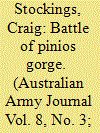

|
|
|
| 2 |
ID:
102859
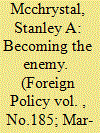

|
|
|
| 3 |
ID:
103437


|
|
|
| 4 |
ID:
109557
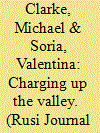

|
|
|
| 5 |
ID:
148591
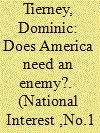

|
|
|
|
|
| Summary/Abstract |
IN THE first century BC, the Roman historian Sallust wrote that the republic had descended into internal strife because of the destruction of its enemy, Carthage, in the Third Punic War. Fear of the enemy, or metus hostilis, produced domestic cohesion. Without an adversary, Romans turned their knives inward: “when the minds of the people were relieved of that dread [of Carthage], wantonness and arrogance naturally arose.”
|
|
|
|
|
|
|
|
|
|
|
|
|
|
|
|
| 6 |
ID:
093060
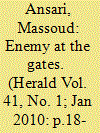

|
|
|
| 7 |
ID:
095728
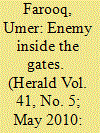

|
|
|
| 8 |
ID:
108686


|
|
|
| 9 |
ID:
115876


|
|
|
| 10 |
ID:
091170
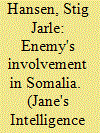

|
|
|
|
|
| Publication |
2009.
|
| Summary/Abstract |
Supporting allies in a conflict in foreign lands is an adventure fraught with difficulty. As imperial powers regularly discovered, local powerbrokers can often incite violent opposition that undermines any influence they have. Moreover, the ability to control proxies, who often come saddled with their own personal amitions and enemies, is limited, meaning even if they are successful in brokering power, they may pursue policies antithetical to the patron state. The fact that the anti-Soviet mujahideen in Afghanistan were materially supported by the United States in the 1980s, and went on to forge both Al-Qaeda and the Taliban, is a current example of the dangers of proxy support.
|
|
|
|
|
|
|
|
|
|
|
|
|
|
|
|
| 11 |
ID:
094966
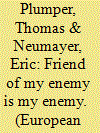

|
|
|
|
|
| Publication |
2010.
|
| Summary/Abstract |
Terrorism is an instrument for groups that cannot achieve their political goals legally. One important strategic function of terrorism is to weaken the government - either directly by attacking representatives or supporters of the government or indirectly by causing a political response that is unpopular among the population. Often, however, political stability of the home government is buttressed by foreign powers. In this case, the terrorists can have a strategic interest in attacking nationals of these foreign countries. This article analyses this logic by looking at international alliances as a proxy for international support. If the friend of my enemy is my enemy, then terror entrepreneurs, which seek to overthrow their home country's government (the enemy), may find it attractive to target nationals of the foreign allies of their country (the friends of the enemy). The theory in this article predicts that attacking nationals of a foreign ally is particularly attractive if this ally is militarily more powerful than the home country. Moreover, the combined effect of alliance and relative power differentials becomes stronger the more democratic the ally and becomes weaker the more democratic the terrorists' home country. Empirical support for the hypotheses in this article is found in an analysis of a directed country dyad sample of international terrorism.
|
|
|
|
|
|
|
|
|
|
|
|
|
|
|
|
| 12 |
ID:
096874


|
|
|
| 13 |
ID:
099698
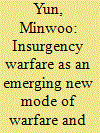

|
|
|
|
|
| Publication |
2010.
|
| Summary/Abstract |
Asymmetric insurgency warfare is the dominant form of conflict today. The global community has been observing this form of conflict around the world for the past 15 years. The current insurgency warfare is substantially different from warfare of commonsense. This new enemy, the so-called insurgents, is a group of small irregulars, terrorists, religious fanatics, and criminals. Strikingly, the highly advanced and mighty military such as the U.S. forces cannot completely win this battle, despite so much efforts and sacrifice. Rather, the inferior Islamic insurgents seem to be gaining in strength. This paper is an attempt to understand today's irony. For doing so, it tries to explain: (i) what the historical meaning of asymmetric insurgency warfare is; (ii) who this new opponent, called Islamic insurgents is; and (iii) how this new enemy fights. This paper argues that the current asymmetric insurgency warfare should be understood beyond modernity. It suggests that the insurgency warfare is a new mode of warfare, the identity of the Islamic insurgents is a network comprising insurgents, terrorists, tribal warriors, and criminals, thus blurring definitional boundaries of war-methodology. The current insurgency warfare, including the conflicts in Afghanistan and Iraq, are examined in this article. The current insurgency warfare, including the 2001 Afghanistan and the 2003 Iraq, is examined in this article.
|
|
|
|
|
|
|
|
|
|
|
|
|
|
|
|
| 14 |
ID:
120460
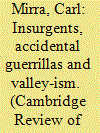

|
|
|
|
|
| Publication |
2013.
|
| Summary/Abstract |
In recent years Western policy towards Afghanistan has been marked by inconsistencies and errors. This article explores United States (US) soldiers' perceptions of the enemy in Afghanistan based on oral history interviews with dissenting combat soldiers who served in the Afghan theatre. By foregrounding soldiers' attitudes towards the enemy, this study includes marginalized voices, often overlooked, that challenge prevailing misconceptions. General David Petraeus, the former commander of US forces in Afghanistan, has argued that significant battlefield decisions are not reserved for generals alone. Petraeus' counterinsurgency programme promotes 'strategic corporals' whose decisions hold important consequences. If strategic corporals are involved in military decision-making, it follows that their interpretation of the conflict may also hold strategic implications for the researcher. Soldiers' views of war are not the final, authoritative verdict. However, this article suggests that these strategic corporals should be included in a complex matrix of interpretation to broaden US understanding of the enemy.
|
|
|
|
|
|
|
|
|
|
|
|
|
|
|
|
| 15 |
ID:
101668
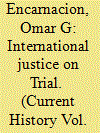

|
|
|
| 16 |
ID:
089287


|
|
|
| 17 |
ID:
148996
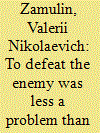

|
|
|
|
|
| Summary/Abstract |
The most important component of any fighting army’s success is its established rear services. Unfortunately, as recently disclosed documents in the Russian Federation’s Central Archive of the Ministry of Defense [TsAMO RF] bear witness, in the spring of 1943 during the preparation for the battle of Kursk, which became a fundamental turning point in the Great Patriotic War, the supply services of the Voronezh Front that was holding the southern shoulder of the Kursk salient were working poorly and seriously affected both the level of combat readiness and the morale of its personnel.
|
|
|
|
|
|
|
|
|
|
|
|
|
|
|
|